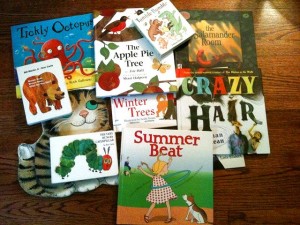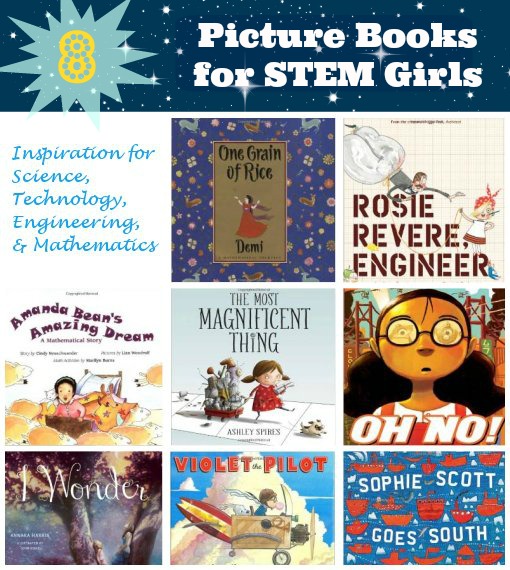With great sadness, I read The New York Times’ (hopefully premature) obituary for the picture book:
The picture book, a mainstay of children’s literature with its lavish illustrations, cheerful colors and large print wrapped in a glossy jacket, has been fading. It is not going away — perennials like the Sendaks and Seusses still sell well — but publishers have scaled back the number of titles they have released in the last several years, and booksellers across the country say sales have been suffering.
The economic downturn is certainly a major factor, but many in the industry see an additional reason for the slump. Parents have begun pressing their kindergartners and first graders to leave the picture book behind and move on to more text-heavy chapter books. Publishers cite pressures from parents who are mindful of increasingly rigorous standardized testing in schools.
This reveals a misunderstanding of both the way children learn and the role of picture books in the learning process.
Forcing academics too early can stifle the imagination. Young children learn to process their world through sensory activities–including looking closely at the images in a picture book. Remove these activities and children are missing an important part of their development–the part that encourages imagination and creative problem-solving.
Young children are highly visual and interesting images build brain connections. Illustrations engage children in the act of making meaning from visual signs. Sparking their creativity, pictures are an invitation to children to “fill in the gaps” in the story. Children “read” the images and “write” their own stories to go with the pictures before they are able to actually read and write fluently.
Christie Burnett at Childhood-101 explains:
Prose which invites the reader into the story through fewer words helps children learn to comprehend, to form connections between the pictures and the words about the meaning being created, comprehension which is vital to learning […] meaning making […]
Picture books also tend to include a lot of the language play that is important to early development: repetition, rhyming, onomatopoeia, and rhythm.
Picture books are still developmentally appropriate for even a very bright child. By choosing picture books with complex themes and ideas and a few higher-level vocabulary words, you can provide stimulation for an intellectually gifted child without bypassing the cognitive benefits of picture books.
Of course, chapter books have their place for children who have the interest and patience. My daughter has enjoyed readings of Winnie the Pooh since she was three. We give her a selection of books we believe have appropriate themes and allow her to choose. When we read chapter books to her, it is a comforting ritual based around the sound of the parent’s voice. When she explores picture books, she more actively engages with the illustrations, sounds out some of the large-print words, anticipates the story line, and asks questions about vocabulary.
Please do not discount the value of fun picture books in creating life-long lovers of literature! If a child picks up an appropriate book–telling him to “put it back” because it is “for babies” communicates that stories are only serious work and not for enjoyment.
To parents who eliminate picture books from their young child’s library, I ask, “Would you rather have a child who reads chapter books by himself at five, or a child who grows into an adult who loves to read.”
Shared at Sunday Best. Read other education and crafting bloggers’ best posts of the week at No Time for Flashcards.



Interesting article Candace.
We are very much a picture book family. We have tons of them and buy more all of the time. I agree that they are incredibly valuable. What I dislike about a lot of them are the subliminal messages that they give to our children about what “normal” or “acceptable” or “desirable” is. I think we need more and better picture books instead of getting rid of picture books.
Good point…I was thinking of that, in part, when I added in “appropriate”. I’m wondering, though, do you find that this is especially a picture book problem or more of a children’s literature (and products, in general) problem? I think that picture books present a unique opportunity to show and celebrate a variety of human expression…particularly as many feature either animals or anthropomorphized creatures.
I’m honestly not a fan of picture books that tackle these issues explicitly, primarily because they don’t seem to have a lot of the joy or magic that classic picture books have and also because I think they “protest too much”, almost highlighting the “strangeness” of what they set out to normalize.
So, I love picture books where the story is about something a child would enjoy–a magical journey, or a bedtime routine, or a walk in the woods–and you just so happen to notice in the illustrations that non-traditional families and roles are depicted.
Or, I love books that send the message about embracing and celebrating differences without enumerating all of the possible differences and human variation…like as in the Sneetches.
Candice,
Great article Candice. Couldn’t have said it better myself. You need to submit this to the NY Times. – I was greatly disturbed by the NY Times article as well. I was sad to see they discussed only the slumping popularity of picture books without having an open discussion of the importance of picture books for our emergent readers. Parents need this education!!! Our teachers, librarians and other educators need to stress to families the critical role that picture books play for our young children…(This includes KG and 1st Grade). The article only reinforced to parents that picture books are dwindling. “Bigger” is NOT better….and I think we are at risk of taking the word JOY out of reading and learning.
I’ve seen young children as young as 4 or 5 wanting to purchase a picture book and witnessing a Mommy tell them it is too young for them. I cringe when I see this. Education is drastically needed. …I will stop here because I’m passionate about this topic!!! Anyways, congratulations Candice on your website. Keep up the great work. Michelle Zimmerman
Hi, Candace!
So glad to see you addressing the essential misunderstanding on which that article was predicated. Below, please find a blog comment I posted on on October 10, 2010, on ZenLeaf, http://zenleaf.amandagignac.com/2010/10/when-quotes-are-taken-out-of-context.html#comments the blog maintained by one of the misquoted interviewees in that article. It goes for your blog, too:
As an author of almost 50 picture books by almost every major house, and the publisher of a celebrated–if tiny–picture book press, I have been skimming comments, both here, and connected to the related NYT article, thinking, “Someone MUST have said what I’d like to, considering the volume!” How relieved I felt to have come upon Susan’s post, which hints at the mistaken premise of all this hoopla!
Picture books are not INTENDED to be “readers”! (I’m not talking about obviously “easy” pb’s, such as those for toddlers, which have the INTENTION of introducing vocabulary.) I’m referring to trade-quality picture books which are intended to be read TO a child. As he listens, (or, when he is competent, reading) the child is also drawing all kinds of inference and enrichment from the pictures.
Now, we could veer off into discussing how illustrations give “context clues” that help children deduce vocabulary, etc., but even that misses the essential point of this very specific art form, since the nature of the illustrations in a really professional pb is that of addressing the SUB-text–that which is UNwritten. When working with two creators–the author and the illustrator–an editor and art director endeavor to make the finished book look as if one mind had created it, even while they are dealing with disparate elements. (I actually left a senior editing position because I was frustrated by how the art director paired irreconcilable styles of art and text, and I have, in contrast, participated in some pb projects that have required dozens of emails of art direction and text corrections before arriving at the brilliant finished product.)
Trade-quality picture books, as a form, are not strictly “educational,” and their primary purpose is not the teaching of reading skills! In my seminars, I teach that the vocabulary of a picture book is akin to that of conversation. Speaking with children, we certainly use “bigger” words than what they will usually find in an easy reader, or an early chapter book. (We often employ these bigger words intentionally, to increase a child’s range of vocabulary, and this happens with pb’s, too, though the teaching of vocabulary should be, at best, only incidental to the author.) If you imagine that picture books are easier to read than chapter books, just try making a list of the words found in your ten favorite pb’s! I find that kids who can breeze through chapter books cannot manage the vocabulary of many picture books, And that’s as it should be. The reason most picture books are bigger than most chapter books is because the pb form is INTENDED to be read aloud–either shared in a lap, or shared held aloft. (Parents are not at all be amazed that–even given the higher vocabulary of pb’s–their children very deeply “get” the story!)
Picture books are an art form unto themselves, and, to my mind, the best ones are “cross-overs,”meaning that they span many–and, sometimes, ALL ages. Some of the most innovative and exciting work in art and text today–and, indeed, for decades–can be found in the underrated form called “the children’s” picture book. (The Children’s Book Council used to maintain a list, “Not Just for Children,” and I do wish we’d revive that list! I imagine there are other adults reading this post who, when they need a break, take stacks of picture books from their shelves and dive into them, relishing the separate-worldliness of the form.)
Amanda, I am SO sorry your intention was misrepresented in that article! But, talking about giving our kids an education from the start–from the time she was very young, my daughter was present at many an interview of me. (This was in the pre-Internet days.) When we read the printed result, she would invariably become indignant. “But that’s not what you meant!” In that way, she learned two things==that people “hear” differently, and the fact of something’s being in print did not necessarily make it Gospel. Even as I read your “quote,” I didn’t believe that was your intention. And it’s intention that matters! Thank goodness for venues like blogs, where one may set the record straight! Cheering for you!
I whole heartedly agree Candace. I saw the article and wrote a post of my own about my beliefs which I’ll publish soon.
I am finding it hard to find “true” picture books anymore. Books with no text or dialogue that my boys use to tell their own stories based on the pictures. I love listening to their interpretation of things, and their imaginations clicking away to develop their own plot lines that are usually far from what I would have thought the author/illustrator was originally going for. Picture books are important!
Howdy! I could have sworn I’ve been to this website before but after reading through
some of the post I realized it’s new to me. Nonetheless, I’m definitely
glad I found it and I’ll be book-marking and checking back frequently!